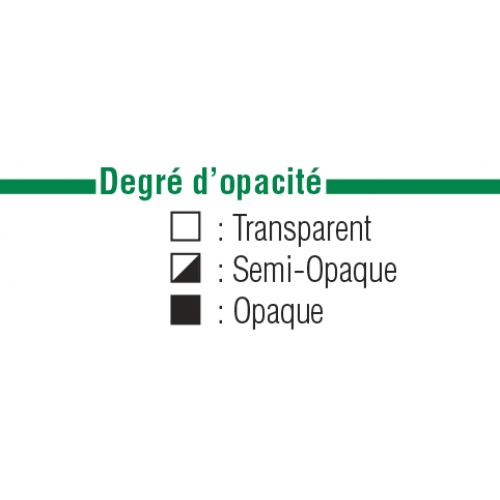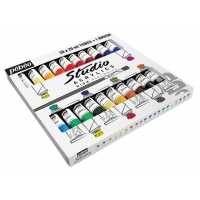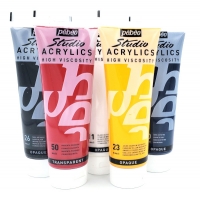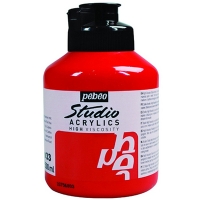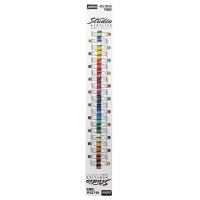Description du produit
STUDIO ACRYLICS: L'ACRYLIQUE SATINÉE SOUS TOUTES SES FORMES !
Pour travailler la matière, rien ne vaut la Studio Acrylics High Viscosity. Épaisse et satinée, cette gamme de peinture acrylique garde l'empreinte du pinceau ou de la spatule.
La Studio Acrylics Fluid, satinée et fluide, fera son affaire de la recherche de détails. Appliquée au pinceau, elle permet des tracés fins et réguliers, des effets glacis et des effets aquarellés.
Leur 766218036575 766218011909 016455269305 766218036636 formulation est garantie sans métaux lourds, toxiques pour l'environnement.
Amateurs ou professionnels des beaux arts et de la peinture acrylique, essayez la gamme Studio Acrylics et appréciez sa texture satinée et fluide !
Télécharger le nuancier.
Pour travailler la matière, rien ne vaut la Studio Acrylics High Viscosity. Épaisse et satinée, cette gamme de peinture acrylique garde l'empreinte du pinceau ou de la spatule.
La Studio Acrylics Fluid, satinée et fluide, fera son affaire de la recherche de détails. Appliquée au pinceau, elle permet des tracés fins et réguliers, des effets glacis et des effets aquarellés.
Leur 766218036575 766218011909 016455269305 766218036636 formulation est garantie sans métaux lourds, toxiques pour l'environnement.
Amateurs ou professionnels des beaux arts et de la peinture acrylique, essayez la gamme Studio Acrylics et appréciez sa texture satinée et fluide !
Télécharger le nuancier.
Spécifications
Spécialement conçue pour les professionnels et les étudiants, l'Acrylics Studio High Viscosity de Pébéo est fine, elle est adaptée au travail de la matière sur toile, carton, bois, métal, ...
Elle garde l'empreinte du pinceau ou de la spatule, et s'utilise pure, avec les Médiums Acryliques ou avec les Auxiliaires Studio ce qui permet encore d'élargir les perspectives créatives.
La gamme contient des couleurs opaques, semi-opaques et transparentes. L'opacité d'une peinture est sa capacité à occulter la surface sous-jacente. Une couleur de peinture est dite opaque lorsqu'elle cache ce qu'il y a dessous, et transparente, si la sous-couche est visible. En fonction de l'effet recherché, le peintre choisira une couleur opaque ou transparente. Par exemple, un glacis nécessite une couleur transparente alors qu'un aplat une couleur opaque. Pour se rapprocher du rendu de l'aquarelle, le peintre sélectionnera une couleur transparente.
La polyvalence de la gamme permet de travailler une quantité infinie de textures.
Lorsque la couleur est appliquée en épaisseur, il est conseillé d'attendre 1 à 2 semaines avant de vernir l'oeuvre. (Source site web Pébéo.)
Elle garde l'empreinte du pinceau ou de la spatule, et s'utilise pure, avec les Médiums Acryliques ou avec les Auxiliaires Studio ce qui permet encore d'élargir les perspectives créatives.
La gamme contient des couleurs opaques, semi-opaques et transparentes. L'opacité d'une peinture est sa capacité à occulter la surface sous-jacente. Une couleur de peinture est dite opaque lorsqu'elle cache ce qu'il y a dessous, et transparente, si la sous-couche est visible. En fonction de l'effet recherché, le peintre choisira une couleur opaque ou transparente. Par exemple, un glacis nécessite une couleur transparente alors qu'un aplat une couleur opaque. Pour se rapprocher du rendu de l'aquarelle, le peintre sélectionnera une couleur transparente.
La polyvalence de la gamme permet de travailler une quantité infinie de textures.
Lorsque la couleur est appliquée en épaisseur, il est conseillé d'attendre 1 à 2 semaines avant de vernir l'oeuvre. (Source site web Pébéo.)



